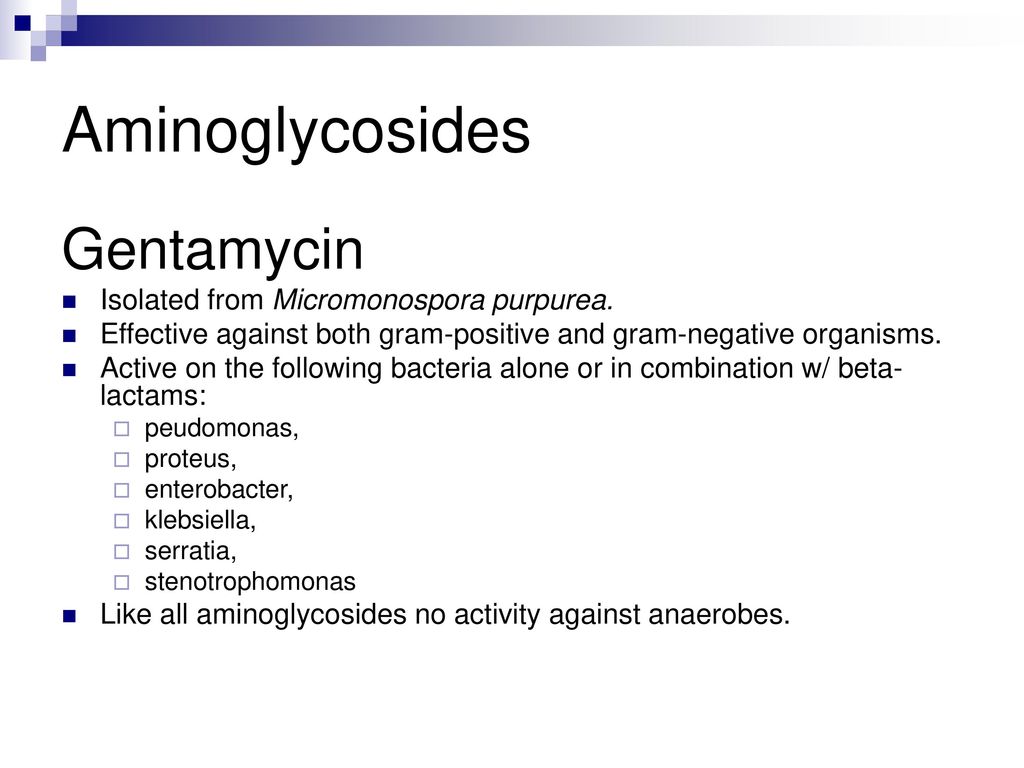Aminoglycosides Are Mostly Effective for Which of the Following
Amikacin Streptomycin Tobramycin Gentamicin 5. Comparatively aminoglycosides are ineffective against streptococci and anaerobic bacteria.
Which type of isolation requires the following.

. Penicillin was considered a miracle drug for all of the following EXCEPT. ADRsToxicity CNS infection allergies - Neuromuscular blockade - respiratory difficulties decreased Ach release receptor blockade with anestheticsneuromuscular blockers but can be attenuated with calcium salts - Superinfections - Usually low incidence of allergy Dosing Based on Creatine Clearance Diagram. In patients with normal renal function onceday dosing is.
Gentamycin is used with ampicillin for synergistic effects in the treatment of enterococcal endocarditis. And neomycin is used in the treatment of skin infections associated with wounds and burns. Aminoglycosides are used in the treatment of severe infections of the abdomen and urinary tract as well as bacteremia and endocarditis.
Some experiments have shown their effectiveness in the treatment of cystic fibrosis. Aminoglycosides are used most widely against. It was the first antibiotic.
Aminoglycosides are most effective in the treatment of aerobic Gram-negative infections. Beyond their role in treating complicated infections they are perhaps more integral to surgical practice used in approximately 30 of prophylactic measures 55. Aminoglycosides are particularly potent against members of the Enterobacteriaceae family including Escherichia coli Klebsiella pneumoniae and K.
They are often used in combination with other antibiotics. This order of potency reflects the number of positively charged amino. The importance of regeneration for protection against renal dysfunction is clearly demonstrated by the fact that laboratory rats survive the repeated administration of relatively high daily doses of aminoglycosides typically 40 mg for gentamicin per kg per day for at least 42 days.
Usually once cultures of the causal organism are grown and their susceptibilities tested aminoglycosides are discontinued in. Gram neg enteric bacteria. Aminoglycosides are most effective against these types of bacterial e.
In the empiric treatment of severe bacterial infections of unidentified entiology this drug often used in combination with an aminoglycoside provides coverage against many staphylococci a Amoxicillin b Clavulanic acid c Erythromycin d Nafcillin e Tetracycline 20. All anti-infectives are natural substances produced by one organism that is capable of destroying or inhibiting the growth of bacteria. Effective in the treatment of infections caused by anaerobes such as Bacteroides fragilis.
D Aminoglycoside antibiotic drugs are not effective against fungi. Oxytoca Enterobacter cloacae and E. The most effective agents were gentamicin and neomycin both of which produced half-maximal relaxation of the contractions induced by ET-1 at 05 m M and 06 m M respectively.
Aminoglycosides are highly effective antibiotics and are resurgent as a consequence of alarming resistance rates to other antibiotics. Amikacin is commonly used in the treatment of infections that are resistant to other aminoglycosides. It inhibits gram-positive cell wall synthesis.
Aminoglycosides are 8 streptomycin neomycin kanamycin amikacin gentamicin tobramycin sisomicin netilmicin. 1 2 The term can also refer more generally to any organic molecule that contains amino sugar substructures. Streptomycin and kanamycin were less effective and the EC 50s for these agents were about 2 and 19 m M respectively Table 1.
Citation needed The most frequent use of aminoglycosides is empiric therapy for serious infections such as sepsis complicated intra-abdominal infections complicated urinary tract infections and nosocomial respiratory tract infections. A Aminoglycoside antibiotic drugs are not effective against viruses. B Aminoglycoside antibiotic drugs are not effective against parasites.
Aminoglycoside is a medicinal and bacteriologic category of traditional Gram-negative antibacterial medications that inhibit protein synthesis and contain as a portion of the molecule an amino-modified glycoside sugar. Penicillins Penicillin is the most effective antibiotic and the least toxic. Multydrug resistance is only a problem in the hospital setting.
Aminoglycosides are active against various Gram-positive and Gram-negative organisms. Water soluble What characteristic of aminoglycosides make them poorly absorbed in the GI typically given via IM or SC injection and poorly cross lipoidal barriers. Aminoglycosides have a hexose ring or 2-deoxystreptamine with various Amino sugars attached with.
Aminoglycosides are most effective against which kind of microorganism. Coli klebsiella enterobacter proteus pseudomonas and salmonella. 5 mgkg 7 mgkg if patients are critically ill.
For an antiviral to be most effective the drug must be given before the disease begins because a virus reaches its peak before clinical symptoms appear. Infectious disease is no longer a leading cause of morbidity or mortality throughout the world. For example gentamicin and tobramycin may be used in the treatment of meningitis sepsis and pneumonia.
Aminoglycosides are thought to work by inhibiting protein synthesis inside bacteria. It has selective toxicity. Aminoglycosides work by irreversibly binding to the 30 ribosomal subunit.
The effectiveness of aminoglycosides against aerobic gram-negative bacilli and Mycobacterium tuberculosis is well-known. Though it is mostly administered intravenously the inhalation or irrigation method might be used sometimes. Aminoglycosides are a class of antibiotics used mainly in the treatment of aerobic gram-negative bacilli infections although they are also effective against other bacteria including Staphylococci and Mycobacterium tuberculosis.
Aminoglycosides are used for a variety of infections. Keep the patient in a separate room. IV aminoglycosides are given slowly 30 minutes for divided daily dosing or 30 to 45 minutes for onceday dosing.
All the following statements about the clinical uses of the aminoglycosides are accurate except. Click card to see definition. It does not effect against eukaryotic cells.
Aerobic gram-negative bacteria Anaerobic gram-negative bacteria Aerobic gram-positive bacteria Anaerobic gram-positive bacteria 6. All of the following statements about the clinical uses of the aminoglycosides are accurate except A Effective in the treatment of infections caused by anaerobes such as Bacteroides fragilis B Gentamycin is used with ampicillin for synergistic effects in the treatment of enterococcal endocarditis. They are also used for prophylaxis especially against.

Organisms That Produce Specific Aminoglycosides Download Table

Comparative Information On Toxicity Of Aminoglycoside Download Table

Do Aminoglycosides Have Lower Penetration Into Bacteria At Low Ph Because They Get Stuck In The Cell Wall

No comments for "Aminoglycosides Are Mostly Effective for Which of the Following"
Post a Comment